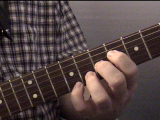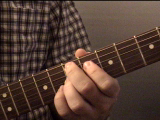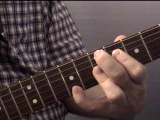Scroll through the lesson and click on notation/video/audio links to load the interactive players.
Please subscribe to get full access to all lessons for only $7.95/month PLUS 1 week free trial.

Riff Interactive lessons are
LESS expensive and
MORE interactive than alternatives!
More Info
|
|
| Lesson Subject:
Lead Guitar Styles |
| What you learn:
Jazz-Rock Soloing |
| Teacher:
Storm Stenvold |
Storm:
Hi. Thanks for tuning in. This lesson is on Jazz-Rock
soloing. I think a lot of what we cover tonight
will work in other contexts, too. Go ahead and load the jam track. It is
in the Key of 'E'. It is a typical Jazz-Rock/Fusion jam.
Kind of staying put on one chord but with lots of possible note
selections.
Storm:
It may be best described as a 'Dominant' Vamp. Or static dominant. Most
specifically E13#9.
E13#9

AScriabin: Like the 'Jimi' chord.
Storm: You got it AScriabin. But with one extra
note. Jimi Chord: E7#9. Or the 'Jimi Hendrix'
chord.
E7#9

Storm: This vamp hints at many possible
alterations/extensions. That is part of the fun of soloing on
it!
E13

Storm: But in its essence it is an E7
chord. The 'seventh' chord is the chord most
blues progressions use. The blues background behind this style
of music gives a valuable perspective for understanding the various
improvisational theories which will be discussed here. The 'E7' chord contains a 'G#' the '3'
of 'E' blues. A typical choice might be the major
pentatonic. Or the minor pentatonic, rooted on 'E'.
Storm:
The tab example shows the 'E' Major Pentatonic scale. This, in theory, is a
fundamental fit to the notes of the 'E7' chord. Highlighted is an additional
note, the 'b3' of the 'minor pentatonic' scale. The intermingling of the 'b3' and '3' is
a trademark blues sound. To the point where listeners are quite
comfortable hearing a 'b3rd' G-natural over the I7 or E7
chord'.
Storm:
The major pentatonic is used to bring out the major aspects of the E dominant
groove. Learn the sound and the numerical values of the notes. 1-2-3-5-6-1-2
etc. It is important to have control of some
minor influence to give pattern more
'depth'. The 'b3' will be handy either as a
subtle influence, using it to approach the '3'. Or for creating a more direct minor
sound by playing it solidly or bending up to it from the
'2'. Like in the lick
example.
Storm:
The next tab shows the minor pentatonic + b5 or the 'blues' scale in the primary
notes. This would be the standard scale for
blues improvising and is a first rate choice over this static dominant
groove. The highlighted note indicates the
major. Giving a hint of the major
'3'. This pattern emphasizes a minor
orientation with a major ornamentation approach. Again, the numerical knowledge is
crucial. 1-b3-3-4-b5-5-b7-1-b3 etc..
Storm:
As you get familiar with the sounds of each of these possible approaches you can
get more adventurous with the
combinations.
Storm:
If you resolve the licks nicely you may never hit a 'wrong' note over this
vamp. Ending in the right place is of prime
importance though. I like to target chord tones of the
'E7'.
Storm:
A dozen right notes sound wrong with the 'wrong' ending note. Or a bunch of
'outside' notes sound great if you 'resolve' the phrase. Chord tones as target
ending notes provide strong resolution. Another choice is an alteration of the
Major Pentatonic. The 'Dominant'
Pentatonic.
Storm:
It is the Major Pentatonic but substituting the 'b7' for the
'6'. It also could be called an 'E9'
arpeggio. Five note pattern either way. Again work in the 'minor flavors' where
you see fit. 'Minor' flavors likely mean 'b3rd' and/or 'b5.' Thinking of the E groove as a pure E7th
places the chord in the V7 of the 'A' major scale
Storm:
When the tonal center of a song is the fifth note a major scale you refer to it
with the modal name 'Mixolydian'.
Storm:
You normally 'letter name' modes after the letter of the tonal center. i.e. 'E Mixolydian'.
Storm:
You can not only use the A major scale for improvisation but you can use other
elements from an extensive range of 'A' major concepts. Or example, you could arpeggiate 'D'
and 'E' chords, both in the key of A, against the E7.
Storm:
Or, since the key of A major contains B minor and C# minor chords, you could
substitute in the pentatonics rooted off those notes.
Storm:
Because we are accepting the 'b3' as an available chord tone we can also analyze
this chord as a minor 7th. The scale closest in construction to the
Mixolydian is the 'Dorian' mode.
Storm:
It is identical to the 'Mixolydian' but with a 'b3rd' or 'minor 3rd' instead of
'3'. The Dorian is in the second position of
the major scale family tree which leads you to a 'D' major parent
scale. You can use the 'D' major scale for
improvisation as well as other 'D' concepts, just like the 'A' concepts
discussed earlier. Just move the earlier licks up 5 frets.
Or down 7 frets. Now we are going where few have gone
before (Star Trek reference). In to the uncharted territory (for most)
of the 'Melodic Minor' scale. (cue Star Trek theme). Actually a mode of the Melodic Minor is
a great choice over static dominant vamps. The 'Lydian b7'
mode.
Storm:
This is the same as playing a 'B' Melodic Minor scale. Also the same as the 'E'
Mixolydian but raising the 4th degree or '#4'. #4 = b5.
Storm:
And another 'jazzy' choice for the static dominant vamp. The Diminished scale.
Storm:
It is called the half-step, whole-step Diminished because its construction
begins with a half-step, then a whole-step, alternating
throughout.
Storm:
I would suggest playing the scale pattern by sliding your 1st finger on the
opening note to the 'b2', then using a 1-3-4 to 1-2-4 fingering throughout. This Diminished scale includes the notes
of the E7 chord with nice 'altered' or 'outside' tones. The 'b9' the '#3' and the
'b5'. We will look at common jazz scale
choices over dominant chords next lesson as we look at soloing in a Jazz style.
Over a 'Jazz Blues' progression. The Jazz-Rock style mixes elements of
traditional Rock and Blues with the more 'outside' or extended note choices
common to Jazz. And this is a nice point at which
players from both side, Rock and Jazz, can come together and both express
themselves equally. Static vamps. I hope you learned something new for
your fingers and ears to wrap themselves around. Thanks for tuning in tonight.
Storm:
Next week Jazz soloing.
|
<< load notation from left
|
|
<< load audio from left
|
<< load audio from left
|